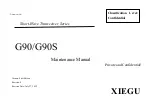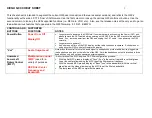
®
N6747V1 4/98
I NS TALLATI ON
I NS TRUCTI ONS
5816MN
DOOR/WINDOW TRANSMITTER
For use with QED control panels ONLY!
PLATE
MOUNTING
HOLES (2)
LOCATE
WIRE EXIT
HOLE IN
WALL HERE
(IF USING
CONCEALED
WIRING)
CASE
LOCKING
TAB
1/4" DIA. MAX.
CASE
HOLDING
POSTS (2)
Figure 1. Mounting Plate
GENERAL INFORMATION
Each 5816MN Door/Window Transmitter has its own
unique serial number permanently assigned during
manufacture. The QED control unit is required to
"enroll" the transmitter ID at some point prior to its
usage in the alarm system. Refer to the QED control
unit's installation instruc tions for further details.
Note:
During programming of the QED control unit, 5816MN
transmitters should be treated as "RF" (i.e. supervised
RF) Type (
mandatory for UL installations ).
The 5816MN can send
two unique codes, the first for a
wired closed circuit contact loop and the
second for its
built-in reed switch (used in conjunction with a magnet
as described below). A wired loop and/or reed switch
may be used.
For UL installations, a contact may not
be more than 3 feet from the transmitter.
The 5816MN includes a built-in cover tamper which is
activated when the cover is removed.
MOUNTING
For proper orientation of the unit in relation to the
mounting plate, loop wiring, and/or magnet, read all of
this section before installing the unit.
The description that follows assumes that the unit will
be mounted as shown in the diagrams, with the magnet
(if used) located in one of the positions shown in Figure
2. The unit may, however, be installed in
any direction,
as long as the relationship of the unit to its mounting
plate and (if used) magnet is maintained.
Although the unit can be mounted directly to a surface,
it is recommended that the mounting plate be used, for
ease in removing the unit for servicing should it
become necessary.
Before mounting the transmitter permanently, conduct
Go/No Go tests (see QED control's instructions) to
verify adequate signal strength and reorient or relocate
the transmitter if necessary.
1.
Remove the transmitter's cover by inserting the
flat blade of a small screwdriver into the pry-off slot
at the end of the unit farthest from the cover's
decorative ribs (see Fig. 2 for location), and twist -
ing the blade.
2.
Disengage the supplied mounting plate from
the unit by inserting the blade of a small screw -
3-VOLT
LITHIUM BATTERY
(OBSERVE POLARITY)
+
-
REED SWITCH (LOOP 2)
ALIGN MAGNET
BETWEEN MARKS
ON CASE
MAGNET
(OBTAIN
SEPARATELY)
1/2” MAX.
LOOP TERMINALS
(LOOP 1)
WIRE ENTRY HOLE
IN BACK OF CASE
ALTERNATE POSITION FOR
MAGNET
COVER PRY-OFF
SLOT
REED
SWITCH
TAMPER
CONTACT
PINS
ANTENNA
LOCKING TAB
RELEASE
WINDOW
(BENEATH
BATTERY)
COVER
HOLDING
HOOKS
(2)
BREAKOUT FOR
SURFACE WIRING
ACCESS
Figure 2. 5816MN (shown without cover)
driver into the locking tab release window (see Fig.
2) and pressing it against the locking tab (shown in
Fig. 1), while sliding the plate downward along the
case back.
3.
Install the mounting plate, with its case holding
posts pointing up (in this example), in the location
selected as described in the QED control unit's
installation instruc tions. Use the flat head screws
supplied.
Note: If a wired contact loop is to be used, with
concealed wiring, the wire exit hole in the
wall should be in the location shown in
Figure 1, and no more than 1/4" in
diameter.
4.
If a wired contact loop is to be used, feed
concealed wiring through the slot in the case back,
but do not connect to the ter minal block yet. For
surface wiring entry, a thin "breakout" area is
provided in the case wall (see Fig. 2 for location).
5.
Attach the case back to the mounting plate by
sliding the key hole slots in the case back down
onto the mounting plate's case holding posts. The
locking tab will click as the case back locks in
place.
6. If one of the reed switches in the unit is to be
used, a No. 5899 Magnet (obtain separately)
should be mounted adjacent to the alignment
marks on the right side of the case, or adjacent to
the bottom of the case (see Fig. 2).
LOOP WIRING CONNECTIONS
(If used)
With the battery still not inserted, connect the contact
loop wires to the unit's loop terminals (see Fig. 2).
Caution: Make sure that the bared sections of the
loop wires do not short to the reed switch.
The contact loop must use closed circuit devices. The
loop response time is a nominal 100mSec.
Note : If the contact loop is not to be used, no
connection is needed across the loop terminals.
(continued)
www.PDF-Zoo.com




















